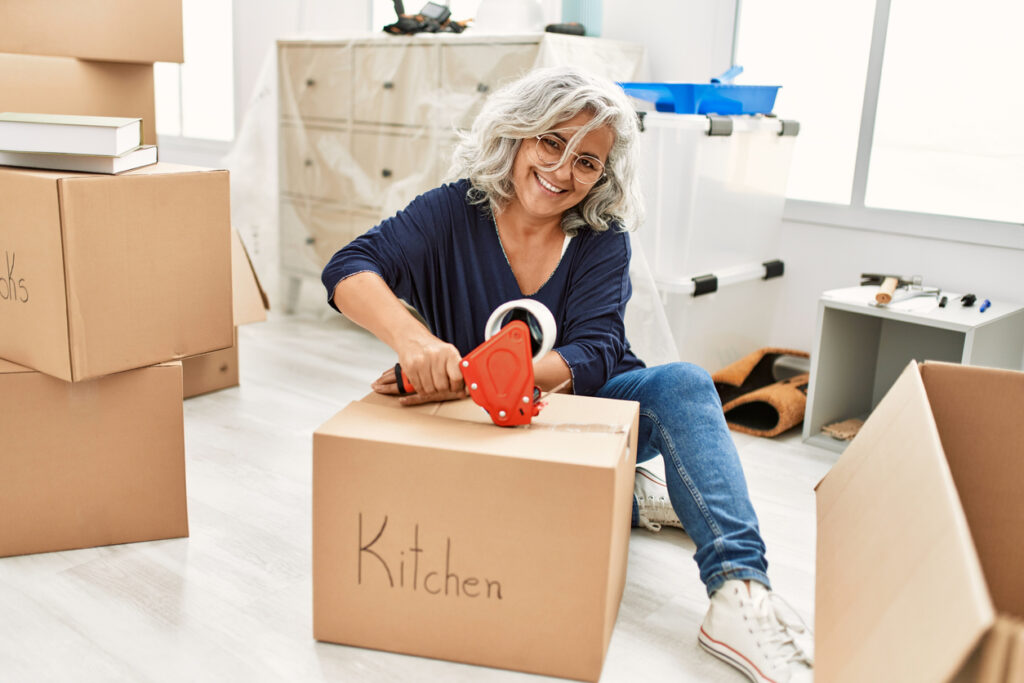
Moving is often exciting—it represents a fresh start and an opportunity to focus on what’s truly important in your life. But, as military members, college students, or anyone else who has moved multiple times in short periods attest, it can be a lot of work.
Fortunately, there are plenty of steps you can take to help limit the hard work of moving and increase the amount of time you spend relaxing at your new place. At Compass Self Storage, we help people move belongings all the time. Our moving ideas, tips, and tricks can help make your move as stress-free as possible.
To help you out, we compiled these tips from moving experts to help you conquer your next move, no matter how big or small it may be.
Moving Tips and Tricks
Moving can seem relatively simple, but the reality is a little more complicated. There are big mistakes that you can make and routine things you can do to help yourself out. We talked to Tillman McClunie II, owner of moving company Humble Hand Movers, about some of the best moving tips and tricks you can do.
1. Throw Away, Store, or Donate Items
If you’re moving into a larger home, it’s always a good idea to identify items you may want to get rid of in the process. After all, there’s never a better time to declutter than in the midst of a move.
This is especially true if you’re downsizing or moving to senior living. “You’ll want to move what you want to use to live on,” McClunie says about deciding what items to move. There are multiple ways to get rid of items. The first is to throw away items that have no value. It’s no use to store or donate these items if everyone has one in their home. As a rule of thumb, the longer you live in your home, the more items you have that you can safely get rid of.
If some items have value but you don’t have space in your new place, we recommend doing one of two things. First, donate items to those in need or bring them to a thrift store. Second, store them in a storage unit. Storage units are affordable and flexible ways to store items you’re not currently using.
2. Don’t Overpack Your Boxes
The core building block of any move is the humble box. Moving boxes come in a variety of sizes. Most of the time, they’re constructed out of heavy-duty cardboard, but you can also get plastic totes, which have the benefit of being see-through.
What’s the biggest mistake most people make when it comes to moving? It’s simple: overpacking your boxes, especially for heavy items like books. “Books should never go in a box larger than the smallest box available,” says McClunie. “All books should go in boxes called 1.5 cubic foot boxes or book boxes. If you put books in any boxes larger than that, it becomes a hazard, and it gets too heavy.”
In other words, it’s better to have many small boxes than one giant heavy box. And if you have a big box, you should actually only be putting light items. “Those larger boxes are really only intended to be 20 pounds,” McClunie explains. “They’re for light and fluffy items. The only thing that should go in those boxes is anything that will not fit in the standard square box and your light and fluffy items like toys, pillows, and comforters.”
If you overpack boxes, you make them impossible for one person to move and introduce a greater risk of breaking what’s inside—and for breaking or hurting yourself, too.
3. Figure Out How To Pack Tricky Items Ahead of Time
Many items can be easily put into boxes, but just as many of your belongings are awkwardly shaped or hard to store in standard boxes. One way to get around this is to buy specialty boxes like wardrobe boxes for tricky items. Another way is to ensure you have large enough boxes to put some awkwardly shaped items into. Even if that box doesn’t have a whole lot of other items, the name of the game is getting everything in stackable boxes that can close.
“We are trying to maximize our space in the truck while we’re loading,” says McClunie. “If you have a bunch of boxes that can’t be closed, most likely we can’t stack anything on top of those boxes because if we put anything on top of open-top boxes, whatever is on top is probably going to get crushed.”
McClunie strongly recommends that you figure out how to pack all oddly shaped or tricky items before the move. “Sometimes we’ll show up, and our customers will say, ‘Oh, well, I didn’t know how to pack this or that’. Then we have to figure out a way to move it without damaging it, and then that just presents a higher risk for everyone involved. Items in a box are at reduced risk of being damaged.”
4. Use Paper and Padding for Breakable Items

Part of the challenge of moving is to figure out how to pack items that can be easily broken in transit. Most likely, the room with the most breakable items is the kitchen. Professional movers recommend paper and padding. “When it comes to breakables, you can never use too much paper,” McClunie says. “Some people like to just wrap a couple of sheets of paper around, and when we’re moving the boxes, we can feel the glass kind of shaking together.” If you or your movers can feel that when you’re moving your box, you probably didn’t use enough padding.
As far as technique, the best way to pack breakable items is to use the layering technique. “When it comes to packing breakables, you also want to ensure that you’re packing your boxes and layers,” says McClunie. “And what I mean by that is through the course of packing the box, starting at the very bottom in different intervals, maybe for every eight inches, you want to make sure you have a cushion of paper layered in the box to cushion everything in the box. That way, everything on the bottom of the box is not bearing the brunt of everything on top of it.”
Additionally, there’s a special kind of box that you should use for kitchen breakables and other delicate items: the dish pack carton. “Dish pack boxes are typically the thickest of any packing box. So the small, medium, and large boxes are not as thick as a dish pack, and dish packs are made thicker because typically those are the boxes that glass and breakables go into.”
Moving Company Tips
When preparing for a moving company to arrive on the big day, there are a few key things you’ll want to figure out beforehand. Some of them can have ramifications on how much they’ll cost!
To Pack or Not To Pack
If you’re hiring a moving company, you’re almost certainly asking them to move your heavy lifting. But did you know that many moving companies will pack for you? If you don’t want to or don’t have time to pack, that can be a load off your mind. But note that this service will come with an additional charge.
What you don’t want to do is to say that you’re going to pack yourself and then surprise your movers with that on the day of the move.
Have a Game Plan Before Movers Come
What’s the biggest challenge when it comes to moving people? We asked McClunie, and his response was simple. “The biggest challenge when it comes to moving someone is moving people whose packing isn’t done. If your packing isn’t done, it doesn’t provide a clear view of what needs to be moved because we have to keep asking, ‘Does this go? Does this bag go?’
One additional thing to consider is to keep furniture that will be moved clear. “If you have pieces of furniture and there are still items on there that are unpacked, well, it makes our job harder because now we can’t move that item expeditiously because we have to take the time to move items off the piece of furniture.” The easier the job is for movers, the faster they’ll go and the lower the chance of items getting damaged in transit.
Movers Charge by the Hour, So Be Prepared
“If it’s a local move, moving companies tend to charge you by the hour,” McClunie says. What does that mean for you—the person who is being moved? Every delay will cost you money once the movers exceed their predicted time slot.
Preparation is, therefore, key. Communication is also crucial. Again, movers are happy to help you with your move—just make sure you tell them the full scope of work before they show up, whatever that may be.
Will Movers Move You Into a Storage Unit?
Yes, most movers will move you into a storage unit. It’s a very common thing for movers to do. If that’s the case, make sure that you have the best storage unit available. If you’re moving most of the contents of your home, we recommend a climate-controlled storage unit for maximum protection against the elements.
Compass Self Storage Is Here For Your Move
Whether you’re moving far or just a few streets away, the moving process takes a lot of planning and work. Compass Self Storage is here to help. With month-to-month leases and affordable storage units across the country, our storage facilities can help you make the most out of your move. Call us or rent online today!






